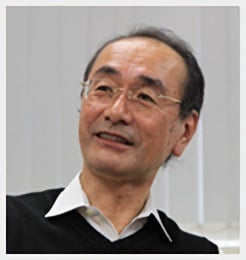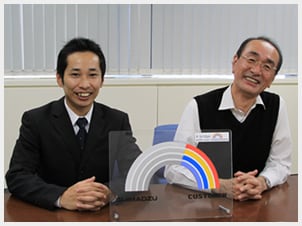
Co-Sense for Impurities

INDUSTRY
KEYWORD
INTRODUCTION SERVICE&PRODUCTS
Co-Sense for Impurities, Co-Sense for LC-MS
Co-Sense series systems are online sample preparation LC systems designed to improve productivity by automating complicated sample preparation processes. The Co-Sense series has been commercialized through a joint development project between Eisai and Shimadzu. The following is from an interview with Mr. Asakawa, who was involved in developing the Co-Sense series, regarding the background that led to developing the series and features of the new product in the series, the Co-Sense for Impurities.
| Note: | The name Co-Sense stands for "Collaboration of Shimadzu and Eisai for New Systematic Efficiency." "Co-Sense" means collaboration on sensitivity, which is the main concept behind these products. It represents users and manufacturers working together to create new value. |

*Affiliates and titles of the interviewee are current as of the time of reporting.
Eisai Co., Ltd.
URL
http://www.eisai.com/
It has now been 11 years since the first product, Co-Sense for NMR/MS, was released. Would you first share some of your memories regarding what led up to the joint development project?

Eisai first started working on this technology in about 1988. We were analyzing the structures of metabolites in urine and blood and started wondering if there was an easier way to purify the metabolites, which involved a cumbersome procedure that sometimes resulted in metabolite degradation during the process. At the time, we tried connecting an LC unit to a FAB MS system for structural analysis, which is how the Co-Sense for MS started.
I remember being extremely impressed by a comment you made in an article contributed to a regular Shimadzu publication, where you said "when I think of doing something easily I think of having fun." Does that mean it gave you joy as a researcher to think about what to do to make things easier?

The word "easy" also implies efficiency, so that was the starting point for developing these instruments. However, MS data alone was not sufficient for determining structures, so NMR data was essential. Many metabolites and degradation products are unstable, so they degrade during the concentration and drying processes of purification by LC. Therefore, we utilized solid phase extraction, which is also used in Co-Sense for MS systems, and eventually conceived of a Co-Sense for NMR system that enabled replacing the solution with about 1 mL of deuterated solvent.
We started joint product development with Shimadzu around 1997 or 1998. At the time, we were having variability problems in analysis results using three LC systems we had purchased from Shimadzu, so engineers were dispatched from Shimadzu in Kyoto for several months while we worked together to determine the cause. That's when I really felt that Shimadzu valued the user's point of view and took it very seriously. I remember being deeply impressed with the earnest efforts by Shimadzu's sales and technical personnel to solve the problem. Even Mr. Nakamoto (current president of Shimadzu Corporation) came to visit the site, where we explained the background and discussed how we could solve the problem together. This series of processes resulted in forming a relationship of trust. That's when we told Shimadzu about the idea we had for an LC/NMR system, which we had submitted for a patent, and invited them to join us in commercializing the product, to which they readily agreed. It's been about 13 or 14 years since we started. We announced our first product at a seminar in 2000.
From Shimadzu's perspective, Eisai allowing us work with them was a priceless opportunity to work together with a customer to create products. Today, we have ongoing joint development projects with a variety of customers, but the joint development project for the Co-Sense series provided the impetus for using the approach more widely for developing products by working together with customers to understand their work and develop solutions.

It makes me happy to hear that and I’m glad that we have continued to work together to this day.
Currently, the hottest product with the biggest potential impact in the Co-Sense series is the Co-Sense for Impurities system, which we released last year. The background for this product is the guidelines for genotoxic impurities (GTI) announced by EMEA (European Medicines Evaluation Agency) in 2006 and by FDA (the U.S. Food and Drug Administration) in 2008. Could you tell us more about that?
The ICH (International Conference on Harmonisation of Technical Requirements for Registration of Pharmaceuticals for Human Use) had already announced mandatory guidelines on determining the structure of, regulating, and reporting impurities, but those guidelines excluded extremely toxic impurities. Ten years later, I suspect that exclusion actually referred to GTIs. As soon as those guidelines were announced, we realized that the Co-Sense for Impurities system could definitely be used to detect GTIs.
Of course, that requires analyzing trace quantities. So you must have been thinking that the Co-Sense's ability to purify and concentrate substances could be applied in that case.

The biggest advantage of the Co-Sense for Impurities system is that it uses UV for detection. UV provides more stable detection than MS, which makes it extremely attractive for quality control applications that require highly sensitive measurements. It also means that anyone can perform accurate measurements at any time and any location. Therefore, it was especially important to include a two-dimensional LC unit with column switching, which enabled UV detection. I think that is a key point about the Co-Sense for Impurities system.
Are you saying that UV detection is superior even after considering the amount of work involved until the last quality control process is finished?
The GTI guideline indicates limit values, called TTC (threshold of toxicological concern). These guidelines specify that given 1 g of a drug is ingested each day for one year, the GTI level must be controlled to 1.5 ppm or less, for example. In that case, 1.54 ppm would be accepted, but 1.55 ppm would be considered nonconforming. The question is: can that level of accuracy be achieved using an MS system for analysis? Establishing a test method involves a lot of work, including validation, but the stability of UV detection ensures samples can be quantitated with sufficient accuracy. That's the important point.
That certainly is an important point, isn't it?

Furthermore, if higher sensitivity is the objective, then there is still plenty of room for improving the Co-Sense for Impurities system. Even now, it is able to quantitate compounds down to the several hundred ppb level. It seems like one of the recent trends is for analysts to use LC/MS for analysis, but I'm not sure if that is a good idea. In any case, the question is: as pharmaceutical manufacturers, how can we consistently supply high-quality pharmaceuticals to patients? Without a solid base, such as a way to ensure the reliability of evaluation methods used to guarantee quality, in some aspects it may be difficult to ensure quality.
MS offers high sensitivity and specificity, but in terms of linearity, UV offers superior stability and capacity for quantitative analysis. When actual applications are considered, there are many analytical applications where the merits of UV detection should be utilized, and where UV should be selected over MS. As a manufacturer, that point needs to be communicated correctly. Now we better understand why the Co-Sense for Impurities was commercialized with UV detection and why it was originally intended for process control applications. Consequently, we designed the software to have a visual and easy-to-understand interface, so that the system is simple to operate, even for a two-dimensional HPLC system that at first glance appears very complicated.
As a pharmaceutical company, are your requirements for manufacturing intermediates and raw materials, for example, becoming more stringent?

GTI guidelines not only affect pharmaceutical manufacturers, but are also directly relevant to manufacturers of raw materials and drug substances. Under GMP, standards for impurities and other characteristics must be specified for starting materials. The quality requirements for starting materials (raw ingredients) and important intermediates are about the same as the requirements for drug substances. In other words, the Co-Sense for Impurities system, which was designed as an analytical instrument for pharmaceutical manufacturers, can also be used by raw ingredient manufacturers and contract manufacturers of drug substances to analyze raw ingredients and drug substances supplied to pharmaceutical manufacturers.
Since it was based on EMEA and FDA guidelines, sales of this product will probably spread globally, such as to India, where there are many drug substance and intermediate manufacturers.
Pharmaceutical manufacturers also procure raw ingredients from overseas chemical manufacturers and also have overseas manufacturing operations, so sales could definitely expand globally. I also hope Co-Sense for NMR and Co-Sense for MS systems are used in combination for the structural analysis of impurities.
As the industry continues to globalize, what do you think Japan's strength is, in terms of analytical technology?
Japan's greatest strength in analysis is accuracy. The accuracy level is quite high. In contrast, efficiency and rationality is the strength of the Europeans and Americans. There is nothing in Japan that matches their speed. The quality of individual data values may be high in Japan, but we need to think more about how to rationalize operations and increase speed. If we continue striving for these aspects, I think we can be competitive in a global environment.
Do you have any opinions or requests for what you want Shimadzu to do in the future?

I think Shimadzu's strength is their ability to discuss various things from the user's perspective. Since we are a manufacturer, sometimes we must handle customer complaints. However, complaints and problems provide especially important information. Resolving complaints provides one tool for building a relationship of trust with users and reveals hidden core issues. Complaints are warnings for the future. If we take them seriously, they can lead to our own progress and development.
In the words of Confucius, "the best advice is the hardest to take." It means that good advice is difficult to accept, but beneficial. Listening only to what is pleasant will only leave you with a happy feeling and will do nothing for your future. Therefore, complaints and candid advice are important and users willing to say them should be valued. Shimadzu seems to be operating based on such a policy, so my request is that Shimadzu continue doing that. Perfection is impossible, so I think Shimadzu should create as many opportunities for communication to share knowledge and expertise toward achieving perfection. That sort of process will provide opportunities to create something new.
The problems at Eisai that led to jointly developing the Co-Sense systems definitely resulted in a lot of work for the engineers, but the experience and knowledge they gained helped them when they were developing the next system. In the future, we hope to increase opportunities for communication, keep listening to the views of users, and develop impressive products.
Lastly, could you share your policies or philosophy regarding analysis?
When making pharmaceuticals, analysis is involved in almost every area of research, from searching for drugs to commercial production. Analysis serves a critical role in each area. The other day, when I was helping with the publication of a book on analysis for drug development, we asked for contributions from 32 researchers from various research fields in pharmaceutical manufacturing. We received contributions from pharmacologists, pharmacokinetics researchers, and safety researchers. What this means is that making pharmaceuticals is about analysis. I hope that analysts truly appreciate how fortunate they are to be involved in analysis and feel the pride associated with analysis. That is, pride for the significance of their work.
Thank you for sharing your valuable time today. We look forward to working together in the future as well.


In recent years there has been an increased interest in impurity analysis methods, not only with respect to the Co-Sense for Impurities system discussed above, but also the Co-Sense for NMR system, developed over 10 years ago to efficiently prepare fractions for NMR analysis, and the Co-Sense for LC-MS system, used for switching to volatile mobile phases for MS detection (related technical document: Technical Report No. 39 Improved Drug Impurity ID Efficiency under CMC using 2-D LC/MS).
We hope to keep working together with customers to offer solutions with a new sense of value and technology, while never forgetting the sense of pride, responsibility, and joy toward analysis that Mr. Asakawa mentioned.